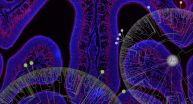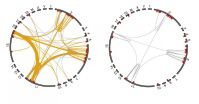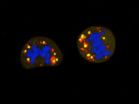INFORMATION:
Deciphering the olfactory receptor code
A tool to identify all the receptors activated by a specific smell, in species ranging from mice to flies, was developed at UNIGE
2015-08-31
(Press-News.org) In animals, numerous behaviors are governed by the olfactory perception of their surrounding world. Whether originating in the nose of a mammal or the antennas of an insect, perception results from the combined activation of multiple receptors located in these organs. Identifying the full repertoire of receptors stimulated by a given odorant would represent a key step in deciphering the code that mediates these behaviors. To this end, a tool that provides a complete olfactory receptor signature corresponding to any specific smell was developed in the Faculties of Science and Medicine of the University of Geneva (UNIGE), Switzerland. Published in the journal Nature Neuroscience, this approach allows to identify thousands of chemosensory receptors, among which, potentially, those able to trigger predetermined behaviors in mammals or in insects, such as pests, disease vectors or parasites.
If we know that mosquitoes track us down thanks to the carbon dioxide we reject, or that salmons find their native river by recognizing its olfactory signature, many of the receptors activated by these stimuli remain unidentified. This extends to the majority of odorants perceived by mammals, as well as pheromones, which trigger or inhibit a specific behavior. From human beings to flies, animals create an odorant representation of the world which surrounds them thanks to the selective and combined activation of receptors present in the sensory organs. The genes coding for these chemosensors, amounting to about 400 in humans and 1'100 in mice, constitute the largest and most diversified group of genes in mammals.
How to take advantage of a discovery
«The olfactory receptors' superfamily has been known for more than twenty years, but the identification of its members which are stimulated by a given odorant has been hampered by technical difficulties. Yet, this represents a key step in deciphering the rules governing chemoperception in animals, including those in human beings», says Ivan Rodriguez, professor at the Department of Genetics and Evolution of UNIGE. In collaboration with Alan Carleton, professor at the Faculty of Medicine, the team of the biologist took advantage of one of its discoveries to try to develop a tool which may serve this purpose. «We observed in mice, after an olfactory stimulation, a decrease in the transcription of genes encoding the receptors activated by the smell perceived», details Ivan Rodriguez.
Countless applications
The approach devised by the researchers actually provides a snapshot of the number and the identity of the receptors stimulated at a specific time in the olfactory neurons of the nose in response to an odorant. «This olfactory signature can also be established in Drosophila, from its antennas. This demonstrates the versatility of our approach and suggests that it could be used to identify populations of neurons active elsewhere than in the olfactory system, in other regions of the brain for instance», notes Daniel Rossier, co-first author of the study.
This method allows to identify, in a few days only, thousands of receptors and, consequently, molecules which can activate or inhibit them. It represents an essential tool to unravel the logic of the chemosensory code across animal species. Its applications, countless, extend for example to the domain of chemicals able to trigger predetermined behaviors in mammals or in insects, such as pests, disease vectors or parasites. «Besides, it is not necessary to know the genome of the species studied, because only the gene transcripts, that is the RNA messengers, which are the gene 'prints', are analysed», explains Ivan Rodriguez.
ELSE PRESS RELEASES FROM THIS DATE:
Come here and be quiet!
2015-08-31
Researchers at the Babraham Institute have discovered a strong physical gene interaction network that is responsible for holding genes in a silencing grip during early development. In the same way that people can interact with others in close proximity, say within the same room, or others millions of miles apart, there are also short- and long-range interactions within the genome forming a three-dimensional configuration where different parts of the genome come into contact with each other. The research, reported online in Nature Genetics, presents how key decision-making ...
Examining service delivery, patient outcomes in Ryan White HIV/AIDS Program
2015-08-31
Outpatient human immunodeficiency virus (HIV) health care facilities funded by the federal Ryan White HIV/AIDS Program (RWHAP) were more likely to provide case management, mental health, substance abuse and other support services than those facilities not funded by the program, according to an article published online by JAMA Internal Medicine.
RWHAP was established in 1990 to provide funds to states, metropolitan areas and clinics to increase access to high-quality HIV care and treatment for low-income, uninsured and underinsured individuals and families affected by ...
Religion, physicians and surrogate decision-makers in the intensive care unit
2015-08-31
Religious or spiritual considerations were discussed in 16 percent of family meetings in intensive care units and health care professionals only rarely explored the patient's or family's religious or spiritual ideas, according to an article published online by JAMA Internal Medicine.
Understanding how frequently discussions of spiritual concerns take place - and what characterizes them - is a first step toward clarity regarding best practices of responding to spiritual concerns in advanced illness.
Douglas B. White, M.D., M.A.S., of the University of Pittsburgh School ...
Exclusive breastfeeding and the effect on postpartum multiple sclerosis relapses
2015-08-31
Women with multiple sclerosis (MS) who intended to breastfeed their infants exclusively for two months had a lower risk of relapse during the first six months after giving birth compared with women who did not breastfeed exclusively , according to an article published online by JAMA Neurology.
About 20 percent to 30 percent of women with MS experience a relapse within the first three to four months after giving birth and there are no interventions for effective prevention of postpartum relapse. The effect of exclusive breastfeeding on postpartum risk of MS relapse is ...
Epigenomic changes are key to innate immunological memory
2015-08-31
It was long believed that acquired immunity--a type of immunity mediated by T- and B-cells--had memory, meaning that it could learn from new pathogens, making subsequent reactions more effective, whereas innate immunity--which is mediated by macrophages and other types of cells that react to certain molecules typically associated with pathogens--did not. However, it gradually became clear that things were not so simple. Plants and insects, which only have innate immunity, also seem to have immunological memory. Further, it has been reported that herpes virus infection increases ...
'Eat me' signal whets appetites for tumor-devouring dendritic cells
2015-08-31
By changing the mouse model they use to study how the immune system responds to cancer, a team of researchers hopes to shift the focus for one emerging form of cancer immunotherapy back to the standard approach--relying on antigen-presenting dendritic cells--and away from the current upstart, macrophages.
Although macrophages, like dendritic cells, also take up antigens, they are more likely to degrade them than present them to T cells. The recent emphasis on macrophages stems, in part, from promising, but problematic, efforts to develop an effective macrophage-driven ...
CNIO scientists propose attacking bioenergetic metabolism to improve anti-cancer therapies
2015-08-31
Cancer cells become addicted to glucose, which they use as their regular source of energy to grow and develop. Although this was observed over nine decades ago by the German physiologist, Otto Warburg; there is still not therapeutic strategy today that can effectively take advantage of this special energy requirement. The initial approach appears to be simple: the lack of glucose could specifically induce the death of cancer cells.
A new study by the Spanish National Cancer Research Centre Cell and Cancer Unit, headed by the Cell Division and Cancer group of the Spanish ...
DNA-guided 3-D printing of human tissue is unveiled
2015-08-31
A UCSF-led team has developed a technique to build tiny models of human tissues, called organoids, more precisely than ever before using a process that turns human cells into a biological equivalent of LEGO bricks. These mini-tissues in a dish can be used to study how particular structural features of tissue affect normal growth or go awry in cancer. They could be used for therapeutic drug screening and to help teach researchers how to grow whole human organs.
The new technique -- called DNA Programmed Assembly of Cells (DPAC) and reported in the journal Nature Methods ...
Closer to a treatment for the 'asthma of the esophagus'
2015-08-31
Scientists from the D'Or Institute of Research and Education (IDOR), the Federal University of Rio de Janeiro (UFRJ) and the Yale University School of Medicine have elucidated the chemical process behind a mysterious gastrointestinal disease that is becoming more frequent every day: the eosinophilic esophagitis (EoE), also known as the "asthma of the esophagus". The researchers identified a molecule which plays a key role in this condition and that can be a target in a new therapeutic strategy.
The eosinophilic esophagitis is a chronic inflammatory disorder of the esophagus. ...
The 5-colour nutritional labelling system is the most effective for consumers
2015-08-31
While the French High Council for Public Health (HCSP) made public on Monday, 24 August 2015, a positive opinion regarding the relevance of the 5-colour code for the public, a team of researchers (Inserm/INRA/Paris 13 University) directed by Serge Hercberg, on publication of their article in the journal Nutrients, demonstrated that the 5-colour nutrition label (5-CNL) is the most effective nutritional information system for allowing consumers to recognise and compare the nutritional quality of foods, including "at-risk" populations (older subjects, those with a lower educational ...
LAST 30 PRESS RELEASES:
Quantum ‘alchemy’ made feasible with excitons
‘Revoice’ device gives stroke patients their voice back
USF-led study: AI helps reveal global surge in floating algae
New method predicts asthma attacks up to five years in advance
Researchers publish first ever structural engineering manual for bamboo
National poll: Less than half of parents say swearing is never OK for kids
Decades of suffering: Long-term mental health outcomes of Kurdish chemical gas attacks
Interactional dynamics of self-assessment and advice in peer reflection on microteaching
When aging affects the young: Revealing the weight of caregiving on teenagers
Can Canada’s health systems handle increased demand during FIFA World Cup?
Autistic and non-autistic faces may “speak a different language” when expressing emotion
No clear evidence that cannabis-based medicines relieve chronic nerve pain
Pioneering second-order nonlinear vibrational nanoscopy for interfacial molecular systems beyond the diffraction limit
Bottleneck in hydrogen distribution jeopardises billions in clean energy
Lung cancer death rates among women in Europe are finally levelling off
Scientists trace microplastics in fertilizer from fields to the beach
The Lancet Obstetrics, Gynecology, & Women’s Health: Taking paracetamol during pregnancy does not increase risk of autism, ADHD or intellectual disabilities, confirms new gold-standard evidence review
Taking paracetamol during pregnancy does not increase risk of autism, ADHD or intellectual disabilities
Harm reduction vending machines in New York State expand access to overdose treatment and drug test strips, UB studies confirm
University of Phoenix releases white paper on Credit for Prior Learning as a catalyst for internal mobility and retention
Canada losing track of salmon health as climate and industrial threats mount
Molecular sieve-confined Pt-FeOx catalysts achieve highly efficient reversible hydrogen cycle of methylcyclohexane-toluene
Investment in farm productivity tools key to reducing greenhouse gas
New review highlights electrochemical pathways to recover uranium from wastewater and seawater
Hidden pollutants in shale gas development raise environmental concerns, new review finds
Discarded cigarette butts transformed into high performance energy storage materials
Researchers highlight role of alternative RNA splicing in schizophrenia
NTU Singapore scientists find new way to disarm antibiotic-resistant bacteria and restore healing in chronic wounds
Research suggests nationwide racial bias in media reporting on gun violence
Revealing the cell’s nanocourier at work
[Press-News.org] Deciphering the olfactory receptor codeA tool to identify all the receptors activated by a specific smell, in species ranging from mice to flies, was developed at UNIGE


